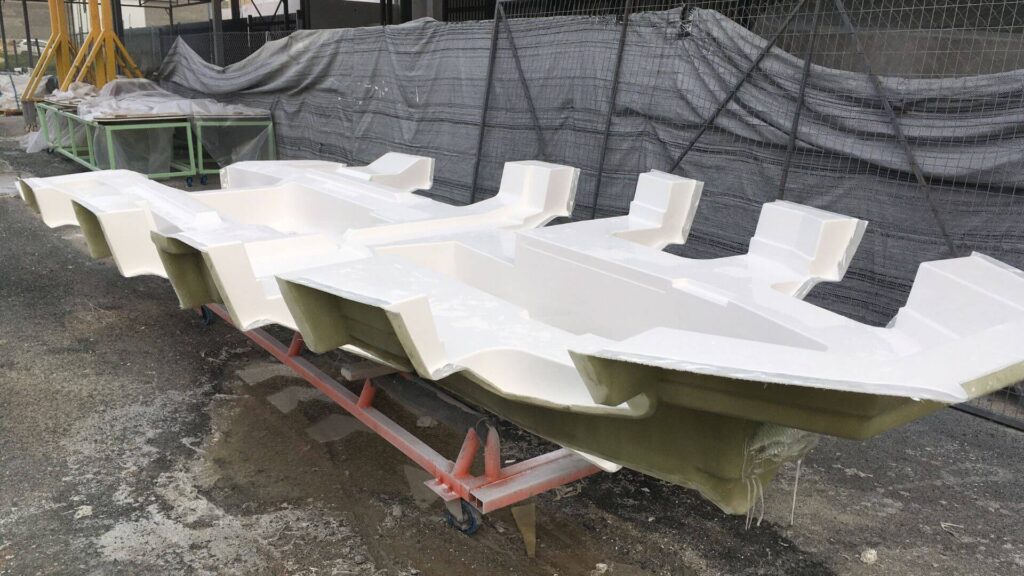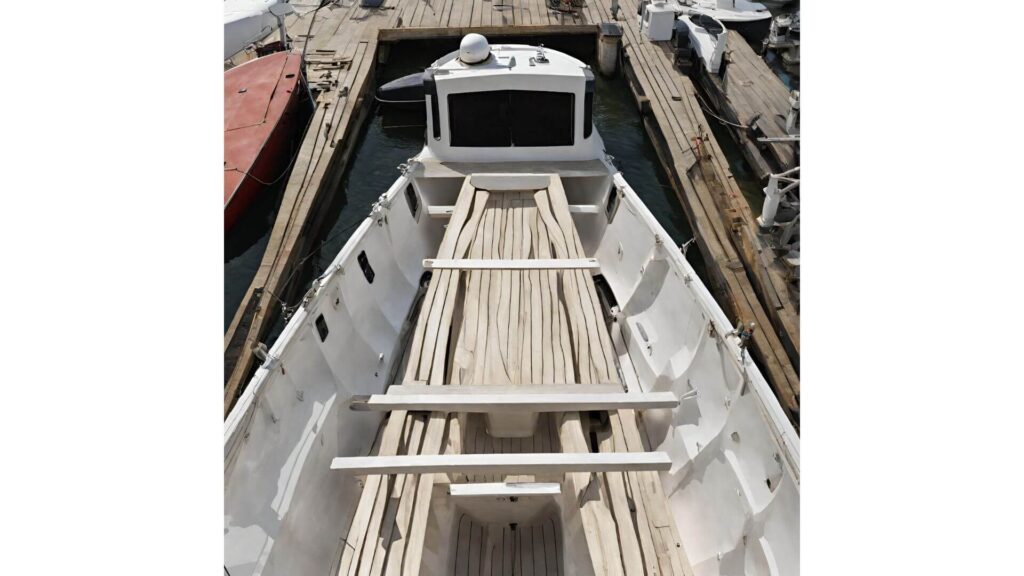Before embarking on the journey of fiberglass boat stringer repair, it’s crucial to recognize that the repair process can vary based on the composition of the stringers.
In this comprehensive guide, we will address two distinct types of stringers commonly found in fiberglass boats:
Repairing Stringers with Wooden Cores:
If your boat incorporates stringers with wooden cores, this section provides a detailed step-by-step guide on assessing, treating, and repairing issues such as dry rot, surface rot, and localized fractures.
Repairing Composite Stringers (Gel Coat, Fiberglass, and Wood):

For boats featuring composite stringers that combine gel coat, fiberglass, and wood, a separate set of considerations comes into play. This section outlines specific steps to address gel coat damage, fiberglass delamination, and wood-related structural issues.
Understanding the nature of your boat’s stringers is the first step towards effective and targeted repair.
But before taking on a major repair project, it’s important to know whether your fiberglass boat stringer needs repair or replacement.
This article covers:
- Assessing if stringers can still be salvaged
- Step-by-step instructions for stringer repair (Both types)
- Tips to protect repairs for the long haul
Which Stringers Can Be Repaired?
Not all stringers showing signs of trouble necessarily need a wholesale repair right away.
If failure or severe structural issues haven’t yet occurred, TLC (Tender Loving Care) can be just what the boat doctor ordered by stabilizing further damage. Consider repairing stringers displaying these conditions:
- Surface rot less than 25% of cross-sectional area
- Localized fractures or cracks (not complete snap failures)
- Early-stage moisture weeping evident
Attempt repairs first before opting for difficult and disruptive total stringer swaps.
If deterioration hasn’t progressed too far, you can likely nurse those stringers back to health by fixing them.
If not, you can simply read my full guide about fiberglass boat stringer replacement here.
The following sections will guide you through the necessary steps to restore your fiberglass boat stringers to their optimal condition.
Fiberglass Boat Stringer Repair Instructions
Stringer With Wooden Cores

Many older fiberglass boats have stringers made with wooden cores, and over time, these can develop issues such as dry rot, softness, surface rot, cracks, or fractures. Here’s how to fix them.
1. Dry out the stringer area completely using fans, desiccants, heat
- Use portable fans and heaters aimed at the affected stringer area
- Place desiccant packs (moisture absorbing beads) surrounding stringers
- Raise temperature to 100-120°F for 1-2 days to fully dry out wood and bilge
- Check moisture meter readings to confirm stringers dried adequately
2. Remove loose or delaminated wood fibers by grinding
- Utilize a rotary grinder or sander to remove any wood portions that are badly damaged, splintered or devoid of structural strength
- Wear proper eye, ear and dust protection
- Grind wood down to a solid, stiff section to establish a clean base for repairs
3. Treat the remaining wood with penetrating epoxy
- Apply thin epoxy designed to soak deep into wood fiber pores
- Brush liberally on exposed wood end grain and sides
- Helps bind and reinforce partially decayed but salvageable interior wood
- Allow the epoxy to fully cure for 24 hours
4. Fill voids or cracks with thickened epoxy
- Mix epoxy resin per manufacturer’s instructions
- Slowly add wood flour or micro balloons to the resin, blending into a peanut butter consistency
- Trowel putty carefully to fill cracks, gouges and rotted-out sections entirely
- Let putty fully harden before sanding smooth
5. Encapsulate repair with fiberglass cloth and resin
- Apply 5-6 layers of woven fiberglass cloth covering the epoxy putty repairs
- Saturate thoroughly with properly catalyzed polyester or epoxy resin
- Works to seal and reinforce fix, prevent future water intrusion
- Let fully cure before reassembling surrounding components
Let me know in the comment section below if any of those steps need more explanation or clarity!
Repairing Composite Stringers (Gel Coat, Fiberglass, and Wood):
Some fiberglass boats utilize composite stringers that combine gel coat, fiberglass, and wood for enhanced structural integrity. Repairing such composite stringers involves addressing issues with both the outer gel coat layer and the internal structural components.
Here’s a step-by-step guide for repairing composite stringers:
1. Surface Inspection
- Carefully inspect the surface of the composite stringer for any cracks, chips, or damage to the gel coat. Gel coat damage can expose the underlying fiberglass and wood, leading to potential structural issues.
2. Gel Coat Repair
- Clean the damaged area to remove dirt and debris.
- Use a gel coat repair kit that matches the color of your boat’s gel coat. These kits typically include gel coat filler and a hardening agent.
- Apply the gel coat filler to the damaged area, ensuring a smooth and even application.
- Allow the filler to cure according to the kit instructions.
- Sand the repaired area to achieve a seamless blend with the surrounding gel coat.
3. Fiberglass and Wood Inspection
- Assess the composite stringer for any signs of delamination, cracks, or decay in the fiberglass and wood layers. Addressing structural issues is crucial for maintaining the strength of the stringer.
4. Structural Repair
- If there are cracks or delamination in the fiberglass layers, carefully remove the damaged sections using a grinder or sanding tool.
- Inspect the wood core for rot or decay. If necessary, cut out the affected wood sections, ensuring you reach structurally sound wood.
- Treat the remaining wood with penetrating epoxy to strengthen and seal it.
5. Fill and Reinforce
- Mix epoxy resin according to the manufacturer’s instructions.
- Fill any voids, cracks, or areas where wood was removed with a thickened epoxy mixture, creating a solid and uniform surface.
- Consider reinforcing the repair by applying fiberglass cloth over the epoxy-filled areas. Ensure thorough saturation with resin.
6. Final Finish
- Sand the repaired areas to achieve a smooth and even surface.
- If needed, apply a final layer of gel coat to the repaired sections, matching the color of the existing gel coat.
- Allow the repair to fully cure before reassembling surrounding components.
By following these steps, you can address both cosmetic and structural issues in composite stringers, ensuring the continued strength and integrity of your fiberglass boat.
==>> You might also like to read my article about fiberglass boat floor repair.
What You’ll Need
1. For Stringers with wooden cores
- Portable fans and heaters for drying
- Desiccant packs (moisture absorbing beads)
- Rotary grinder or sander
- Safety gear (eye protection, ear protection, dust mask)
- Penetrating epoxy
- Epoxy resin for filling voids
- Wood flour or micro balloons for thickening epoxy
- Fiberglass cloth
- Mixing containers and putty knives
- Gloves and respirator
2. For Stringers made of Gel Coat, fiberglass and wood
- Gel coat repair kit
- Grinder or sanding tool for fiberglass repair
- Portable fans and heaters for drying
- Desiccant packs (moisture-absorbing beads)
- Safety gear (eye protection, ear protection, dust mask)
- Penetrating epoxy for wood treatment
- Epoxy resin for filling voids
- Thickening agent (wood flour or micro balloons)
- Fiberglass cloth
- Mixing containers and putty knives
- Polyester or epoxy resin for encapsulation
- Matching gel coat for final touch-ups
- Gloves and respirator
Curing Your Stringer’s Ills for the Long Haul
The key is to not only mechanically stiffen compromised stringers with epoxy and glass reinforcements, but also address the underlying moisture issue.
Ensure repairs are fully sealed and create ample ventilation to keep stringer beds dry.
With TLC and some fiberglass nurturing, you can nurse ailing stringers back to health, save major replacement surgery, and add more great seasons to the water.
Hope this gives you a helpful overview of repairing rotten or damaged fiberglass boat stringers specifically. Let me know if you need any other stringer repair pointers!

